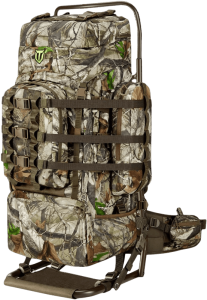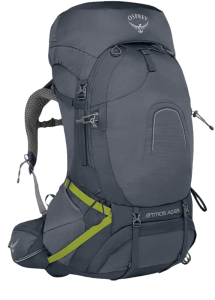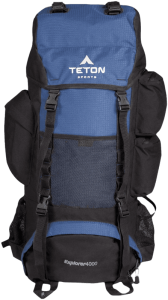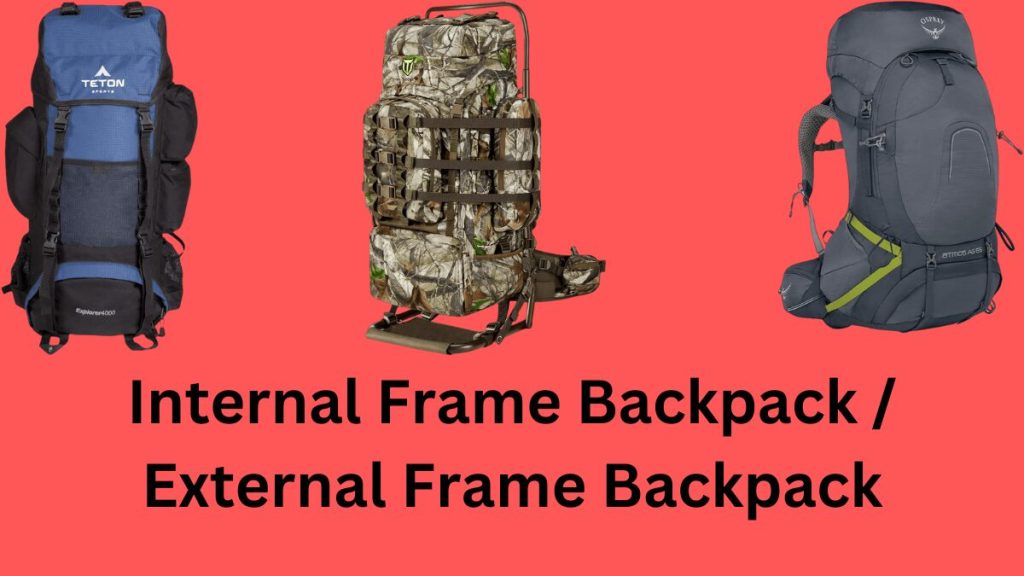Choosing the right backpack is a crucial decision for outdoor enthusiasts, and the debate between internal frame backpack vs external frame backpack has long been a focal point in this realm. These two designs represent distinct approaches to optimizing load-carrying capabilities, comfort, and adaptability for various outdoor activities. Internal frame backpacks, with their sleek, form-fitting designs and hidden support structures, have gained popularity for their ability to navigate challenging terrains and provide a balanced load distribution.
On the other hand, external frame backpacks, characterized by their visible frames and enhanced ventilation, were once synonymous with heavy-load expeditions but have evolved to meet specific needs. As outdoor gear technology advances, understanding the strengths and weaknesses of internal and external frame backpacks becomes essential for adventurers seeking the perfect companion for their journeys.
Definition and Purpose of Backpacks
A backpack, colloquially known as a rucksack or knapsack, is a portable bag designed to be carried on one’s back, secured with two straps that go over the shoulders. It serves as a versatile and practical means of transporting belongings, allowing individuals to carry essentials in a convenient and hands-free manner. The primary purpose of a backpack is to provide a portable storage solution that accommodates various items, such as clothing, food, gear, and personal belongings.
Whether utilized for daily activities, school, work, or outdoor adventures, backpacks are designed to distribute the weight evenly across the wearer’s back, enhancing comfort and mobility. The ergonomic design and functionality of backpacks make them essential tools for individuals on the move, offering a seamless blend of practicality and style in a wide range of contexts.
Evolution of Backpack Designs
The evolution of backpack designs is a fascinating journey marked by ingenuity, innovation, and a deep understanding of human needs in various environments. The origins of backpacks can be traced back to ancient times when simple, rudimentary designs consisted of animal hides or woven plant fibers fashioned into carrying pouches. Over the centuries, backpacks evolved in tandem with the changing demands of human activities.
Middle age
During the Middle Ages, backpacks took on a more structured form, featuring wooden frames that provided support for carrying heavier loads. However, it was in the 20th century that significant strides were made in backpack design. The introduction of materials like canvas and nylon revolutionized the manufacturing process, resulting in lighter, more durable backpacks. World War II further propelled innovation, as military backpacks incorporated features like multiple compartments and adjustable straps, setting the stage for modern designs.
20th century
In the latter half of the 20th century, the outdoor recreation boom spurred the development of specialized backpacks for hiking, camping, and mountaineering. The internal frame backpack emerged as a breakthrough, offering a sleeker profile and improved weight distribution compared to its external frame counterparts. Technological advancements continued to shape backpacks, with the integration of materials like ripstop nylon, waterproof coatings, and ergonomic padding enhancing durability and user comfort.
21st century
As we enter the 21st century, backpack designs have become increasingly sophisticated, incorporating features such as hydration systems, built-in electronics compartments, and advanced suspension systems. The market now caters to diverse preferences and activities, from minimalist ultralight designs for backpacking enthusiasts to rugged, specialized packs for extreme expeditions.
The evolution of backpack designs reflects a dynamic interplay between functionality, comfort, and aesthetics, illustrating how these indispensable tools have adapted to meet the evolving needs of a wide array of users across different eras and pursuits.
Significance of Choosing the Right Backpack
Selecting the appropriate backpack transcends a mere accessory choice; it is a decision laden with profound implications for comfort, efficiency, and overall well-being, particularly in the land of outdoor activities. The right backpack can make the difference between an enjoyable adventure and a cumbersome ordeal, impacting the wearer’s physical health, mental state, and the success of the journey.
ergonomic fit
One crucial aspect is the ergonomic fit that a well-chosen backpack provides. An ill-fitting backpack can lead to discomfort, strain, and even injury, as it fails to adequately distribute weight or conform to the wearer’s body. Conversely, a thoughtfully selected backpack with proper padding, adjustable straps, and ergonomic design enhances comfort, facilitating longer journeys and reducing the risk of physical stress.
functionality
The functionality of a backpack aligns directly with its purpose. Different activities demand distinct features, from the compartmentalized organization for urban commuting to specialized pockets for outdoor gear. The right backpack not only accommodates the specific needs of the user but also ensures quick and easy access to essentials, enhancing convenience and efficiency.
Durability and weather resistance
Durability and weather resistance are paramount considerations for those venturing into challenging environments. A well-constructed backpack crafted from robust materials can withstand the rigors of outdoor conditions, protecting valuable gear and ensuring longevity. Waterproofing, reinforced stitching, and abrasion-resistant materials contribute to the reliability of a backpack in adverse weather or rough terrains.
style
Moreover, the aesthetic and stylistic elements of a backpack can impact the user’s overall experience. Whether it complements a professional setting, aligns with personal fashion preferences, or integrates seamlessly into the outdoor environment, the right backpack becomes an extension of the user’s identity.
In essence, the significance of choosing the right backpack extends beyond functionality; it encompasses considerations of health, efficiency, and personal satisfaction. As a trusted companion on life’s adventures, a well-chosen backpack becomes an essential tool, enhancing the overall quality of the user’s experiences and contributing to the success and enjoyment of their endeavors.
internal frame backpack vs external frame backpack
Anatomy of Internal Frame Backpacks
A. Construction and Materials
The construction and materials of internal frame backpacks are pivotal contributors to their efficiency and functionality. Typically, these backpacks feature a built-in frame made of lightweight yet sturdy materials such as aluminum or carbon fiber. This internal frame is designed to provide structural support while maintaining a low overall weight. The main compartment is often constructed from durable fabrics like nylon or polyester, known for their abrasion resistance and weatherproof properties. Reinforced stitching and quality zippers are integral components ensuring the backpack’s longevity under diverse conditions.
B. Ergonomics and Weight Distribution
One of the defining characteristics of internal frame backpacks lies in their ergonomic design, aimed at conforming to the natural contours of the wearer’s back. This tailored fit enhances stability and balance, crucial for navigating challenging terrains. Adjustable shoulder straps, hip belts, and sternum straps allow users to customize the fit, ensuring optimal comfort during prolonged use. Effective weight distribution is achieved through the integration of the internal frame, dispersing the load evenly across the back. This ergonomic approach minimizes strain on the shoulders and promotes a more energy-efficient carrying experience.
C. Advantages and Disadvantages
Advantages:
- Streamlined Profile: Internal frame backpacks typically boast a sleek and streamlined profile, making them well-suited for navigating narrow trails and confined spaces.
- Balance and Stability: The internal frame, coupled with the ergonomic design, promotes better balance and stability, crucial for activities like hiking and climbing.
- Versatility: Internal frame backpacks are versatile and suitable for various outdoor activities, from day hikes to extended backpacking trips.
Disadvantages:
- Limited External Attachment Points: The internal design often results in fewer external attachment points, limiting the ability to easily strap on bulky or awkwardly shaped items.
- Ventilation Concerns: The backpack’s snug fit against the back can lead to reduced ventilation, potentially causing discomfort during hot weather.
Understanding the anatomy of internal frame backpacks provides insight into the thoughtfully engineered features that contribute to their popularity among outdoor enthusiasts, balancing comfort, versatility, and durability in the pursuit of adventure.
Anatomy of External Frame Backpacks
A. Structural Components
External frame backpacks are characterized by a visible, rigid frame that serves as the foundational structure. The frame is typically crafted from materials such as aluminum, providing durability without excessive weight. This external frame is strategically shaped to follow the contours of the backpack, creating a framework to support the load. Attached to the frame is a fabric or nylon pack bag, which contains compartments for storing gear and essentials. The external frame design often incorporates additional features like multiple attachment points, allowing for the convenient securing of various equipment.
B. Weight Distribution Mechanisms
Weight distribution in external frame backpacks is achieved through a combination of the frame design and the positioning of the load. The frame keeps the pack away from the wearer’s back, allowing for increased airflow and reduced heat retention. This design also promotes a higher center of gravity, which can be advantageous for maintaining balance, especially when carrying heavy loads. The weight is primarily supported by the hip belt, which transfers the load to the hips and, subsequently, the legs. Adjustable shoulder straps and load lifter straps contribute to fine-tuning the fit and optimizing weight distribution for the wearer.
C. Advantages and Disadvantages
Advantages:
- Heavy Load Capacity: External frame backpacks are renowned for their ability to carry heavy loads comfortably, making them suitable for extended expeditions or backcountry trips.
- Ventilation: The external frame design promotes airflow between the backpack and the wearer’s back, reducing heat buildup during warmer weather.
- Versatile Attachment Points: The visible frame provides multiple attachment points, allowing users to secure additional gear or equipment externally, making it suitable for carrying awkwardly shaped items.
Disadvantages:
- Bulkiness: External frame backpacks can be bulkier and less streamlined than their internal frame counterparts, making them less ideal for navigating through tight spaces or dense vegetation.
- Less Stability on Rough Terrain: While external frame backpacks excel on well-defined trails, they may offer less stability on uneven or challenging terrains compared to internal frame backpacks.
- Less Popular in Modern Designs: With advancements in internal frame technology, external frame backpacks have become less common in contemporary outdoor gear, as many prefer the sleeker profiles of internal frame options.
Understanding the structural components, weight distribution mechanisms, and the pros and cons of external frame backpacks provides valuable insights into their design principles and helps users make informed decisions based on their specific needs and preferences in outdoor activities.
Internal Frame Backpack vs External Frame Backpack
Performance in Different Environments
A. Internal Frame Backpacks in Hiking
- Stability on Uneven Terrain: Internal frame backpacks excel in providing stability on uneven terrain during hiking. The snug fit and ergonomic design of these backpacks, coupled with the integrated internal frame, contribute to a balanced load distribution. This ensures that the backpack remains close to the wearer’s body, minimizing swaying or shifting during ascents, descents, and traversing rugged landscapes. Hikers benefit from enhanced stability, reducing the risk of imbalance or discomfort while navigating challenging terrains.
- Maneuverability Through Narrow Paths: The streamlined profile of internal frame backpacks makes them well-suited for maneuvering through narrow paths on hiking trails. The compact design allows hikers to navigate dense vegetation, rocky passages, or tight spaces with greater ease compared to bulkier alternatives. The reduced external protrusions of internal frame backpacks enhance overall maneuverability, enabling hikers to traverse varied and confined terrains without hindrance.
B. External Frame Backpacks in Camping
- Load-Bearing Capacity in a Stationary Camp: External frame backpacks shine when it comes to load-bearing capacity, especially in a stationary camp setting during camping trips. The rigid external frame provides excellent support for heavier loads, making it suitable for carrying a variety of camping gear, including tents, sleeping bags, and cooking equipment. The weight distribution mechanisms, such as the hip belt and multiple attachment points, enhance the backpack’s ability to carry a substantial amount of gear comfortably, contributing to a well-equipped and organized campsite.
- Ventilation in Hot and Humid Conditions: Ventilation is a notable advantage of external frame backpacks, particularly beneficial in hot and humid conditions during camping. The external frame design keeps the main pack away from the wearer’s back, allowing air to circulate and preventing excessive heat buildup. This ventilation feature enhances overall comfort, making external frame backpacks a preferred choice for camping in warmer climates where airflow is crucial for preventing discomfort and heat-related issues.
Understanding the specific performance attributes of internal frame backpacks in hiking scenarios and external frame backpacks in camping environments enables outdoor enthusiasts to make informed choices based on the demands of their chosen activities and the environmental conditions they are likely to encounter.
Capacity and Storage Options
A. Internal Frame Backpacks: Balancing Size and Weight
- Ideal Capacities for Various Activities: Internal frame backpacks come in a range of capacities, each catering to specific outdoor activities. For day hikes, a smaller capacity between 20-40 liters is often sufficient to carry essentials like water, snacks, and extra layers. Backpacks in the 40-70 liter range are ideal for weekend trips or shorter backpacking excursions, accommodating additional gear and supplies. Extended backpacking trips or thru-hikes may require capacities exceeding 70 liters to carry clothing, camping equipment, and provisions for extended periods. Choosing the right capacity ensures a balance between accommodating necessary gear and maintaining a manageable weight for the activity at hand.
- Organization Features: Internal frame backpacks are designed with thoughtful organizational features to enhance efficiency. Multiple compartments, zippered pockets, and gear loops provide designated spaces for different items, aiding in easy access and organization. Some backpacks also feature hydration reservoir sleeves, allowing users to stay hydrated without interrupting their flow. Compression straps and adjustable dividers contribute to the flexibility of the internal space, enabling users to customize the organization based on the specific requirements of their adventure.
B. External Frame Backpacks: Maximizing Cargo Space
- Large Storage Compartments: External frame backpacks are renowned for their expansive storage capacities, making them well-suited for extended trips where a significant amount of gear is required. The large main compartment can accommodate camping equipment, clothing, food, and other essentials. The external frame itself often provides additional attachment points, allowing users to secure bulky items externally, maximizing the overall cargo space. This makes external frame backpacks an ideal choice for those embarking on camping trips where a substantial amount of gear is essential.
- Accessibility and Convenience: Accessibility is a key feature of external frame backpacks, contributing to their convenience in camping scenarios. The design typically allows for easy access to the main compartment through large zippered openings, facilitating quick retrieval of gear without the need to unpack the entire backpack. This accessibility is particularly advantageous when setting up camp or accessing specific items without disrupting the overall organization of the backpack. External frame backpacks, with their straightforward design, offer a practical solution for those who prioritize convenience and quick access to their equipment.
Understanding the balance between size, weight, and organizational features in internal frame backpacks, as well as the emphasis on maximizing cargo space and accessibility in external frame backpacks, empowers outdoor enthusiasts to select the most suitable backpack based on their specific needs and the nature of their adventures.
Comfort and Fit
A. Internal Frame Backpacks: Body-Hugging Design
- Adjustable Straps and Padding: Internal frame backpacks are distinguished by their body-hugging design, optimizing comfort through adjustable straps and padding. These backpacks feature adjustable shoulder straps, hip belts, and sternum straps, allowing users to customize the fit according to their body dimensions. Padded areas on the shoulder straps and hip belts enhance comfort during extended wear, reducing pressure points and minimizing chafing. The adjustability of these components ensures a snug and personalized fit, crucial for comfort on long hikes or backpacking trips.
- Impact on Posture and Comfort: The body-hugging design of internal frame backpacks positively influences posture and overall comfort. By closely following the contours of the wearer’s back, these backpacks promote a more natural alignment, preventing the backpack from pulling the user backward or causing discomfort. The internal frame, in conjunction with the adjustable features, ensures that the weight is evenly distributed across the hips and shoulders, reducing strain and fatigue. This design is particularly beneficial for maintaining comfort during varied terrains and extended periods of wear.
B. External Frame Backpacks: Emphasis on Airflow
- Ventilation Systems: External frame backpacks prioritize airflow, a key element contributing to comfort during extended outdoor activities. The design of the external frame keeps the main pack away from the wearer’s back, allowing air to circulate and dissipate heat. This ventilation is crucial, especially in warmer climates or during strenuous activities where heat buildup can lead to discomfort and fatigue. Some external frame backpacks feature mesh panels or raised designs to further enhance airflow, promoting a cooler and more comfortable experience.
- Adjustability for Different Body Types: External frame backpacks often provide a degree of adjustability to accommodate different body types. Adjustable shoulder straps, hip belts, and torso length settings contribute to a customized fit, ensuring that the backpack sits comfortably on the wearer’s back. This adaptability is beneficial for users with varying body proportions, allowing them to fine-tune the fit for optimal comfort and support. The emphasis on adjustability caters to a diverse range of users and ensures that the backpack can be tailored to individual preferences.
Understanding the emphasis on a body-hugging design with adjustable features in internal frame backpacks and the focus on airflow and adjustability for different body types in external frame backpacks assists users in selecting a backpack that aligns with their comfort preferences and enhances their overall outdoor experience.
Durability and Longevity
A. Internal Frame Backpacks: Resilience in Challenging Conditions
- Durability of Materials: The durability of internal frame backpacks is often attributed to the quality of materials used in their construction. These backpacks commonly employ robust materials such as high-denier nylon or polyester for the main pack, ensuring resistance to abrasion and tears in challenging conditions. The internal frame, often made from lightweight yet durable materials like aluminum or carbon fiber, provides structural support without compromising on strength. Reinforced stitching and quality zippers contribute to the overall durability of internal frame backpacks, enabling them to withstand the rigors of various outdoor environments.
- Maintenance Tips: To prolong the lifespan of internal frame backpacks, regular maintenance is essential. Simple practices like cleaning the backpack after use, especially in muddy or dusty conditions, help prevent the accumulation of debris that could compromise the fabric. Checking and tightening straps, inspecting zippers, and addressing minor repairs promptly can prevent issues from escalating. Storing the backpack in a cool, dry place when not in use helps prevent mold and mildew. Overall, proactive care and periodic inspections contribute significantly to the long-term durability of internal frame backpacks.
B. External Frame Backpacks: Robustness for Heavy Loads
- Frame Materials: The robustness of external frame backpacks, particularly in handling heavy loads, is closely tied to the materials used in the frame construction. Commonly crafted from aluminum, these frames provide excellent strength-to-weight ratios, allowing them to bear substantial loads without compromising structural integrity. The choice of materials in the frame design ensures that external frame backpacks maintain their robustness, making them well-suited for carrying heavy gear during extended expeditions.
- Care and Maintenance: Proper care and maintenance are crucial for preserving the longevity of external frame backpacks, especially considering their role in carrying heavy loads. Regularly inspecting the frame for signs of wear, such as cracks or bends, is essential. Cleaning the backpack after use, paying particular attention to the frame joints and attachment points, prevents the accumulation of dirt and debris that may affect the frame’s performance. Lubricating moving parts, such as hinges or connectors, helps maintain smooth functionality. Storing the backpack in a dry environment and avoiding prolonged exposure to direct sunlight further ensures the backpack’s longevity.
Understanding the durability factors and implementing appropriate maintenance practices for both internal and external frame backpacks contributes to their long-term resilience, allowing outdoor enthusiasts to rely on these essential tools for numerous adventures.
Price Considerations
A. Internal Frame Backpacks: Balancing Quality and Affordability
- Mid-Range Options: In the kingdom of internal frame backpacks, mid-range options offer a balance between quality and affordability. These backpacks typically incorporate durable materials, thoughtful design features, and a reasonable price point. While they may lack some of the advanced features found in premium models, mid-range internal frame backpacks provide a reliable and cost-effective solution for outdoor enthusiasts seeking dependable performance without breaking the bank. Brands in this category often cater to a broad audience, making quality backpacks accessible to a wider range of users.
- Premium Choices and Value for Money: For those willing to invest in premium internal frame backpacks, the emphasis is on advanced features, superior materials, and enhanced comfort. Premium models often include innovative design elements, specialized compartments, and high-end materials such as advanced fabrics and lightweight alloys for the frame. While the initial cost may be higher, the value for money lies in the long-term durability, additional features, and overall performance. Premium internal frame backpacks are an excellent choice for users who prioritize top-tier quality and are willing to make an upfront investment for extended durability and advanced functionalities.
B. External Frame Backpacks: Evaluating Investment for Long-Term Use
- Budget-Friendly Picks: Budget-friendly external frame backpacks cater to users seeking an economical option without compromising essential features. These backpacks typically offer sufficient storage capacity, durability, and basic functionalities for various outdoor activities. While they may lack some of the advanced features found in higher-end models, budget-friendly external frame backpacks are a suitable choice for entry-level users or those with budget constraints. Brands in this category aim to provide a cost-effective solution for individuals looking to explore the outdoors without a significant financial commitment.
- High-End Models and Their Features: High-end external frame backpacks represent an investment in long-term use and advanced features. These models often incorporate premium materials for both the frame and main pack, ensuring durability and load-bearing capacity for extended expeditions. High-end external frame backpacks may also include specialized compartments, advanced suspension systems, and additional attachment points for versatile gear carrying. While the initial cost is higher, the investment is justified by the enhanced durability, comfort, and features that cater to the needs of experienced outdoor enthusiasts tackling challenging environments.
Understanding the price considerations for both internal and external frame backpacks allows users to make informed decisions based on their budget constraints, preferences, and the intended use of the backpack. Whether opting for mid-range affordability or investing in premium features, the goal is to strike a balance that aligns with the user’s specific requirements and expectations.
Load Distribution
A. Internal Frame Backpack Load Distribution:
Internal frame backpacks excel at distributing the load evenly across the wearer’s back. The internal frame, often made of lightweight materials like aluminum or carbon fiber, serves as the backbone of the backpack. The design ensures that the weight is kept close to the body’s center of gravity, promoting stability and balance. Adjustable shoulder straps, hip belts, and sternum straps allow users to fine-tune the fit, facilitating a personalized and comfortable load distribution. This even distribution of weight minimizes pressure points, reduces strain on the shoulders, and contributes to an overall balanced and ergonomic carrying experience.
B. External Frame Backpack Load Distribution:
External frame backpacks distribute the load by utilizing the rigid frame structure. The frame, typically made of aluminum, offers a platform for securing the main pack and additional gear. The weight is transferred to the hip belt, which in turn directs it to the wearer’s hips and legs. The elevated position of the main pack away from the back promotes airflow and allows for a higher center of gravity, enhancing stability when carrying heavy loads. The frame’s design facilitates effective load distribution, especially when navigating challenging terrain or during extended periods of use.
C. Importance of Proper Load Distribution for a Comfortable Hike:
Proper load distribution is crucial for ensuring a comfortable and enjoyable hiking experience. When the load is evenly distributed, it minimizes the strain on specific muscles, preventing fatigue and discomfort. This becomes particularly significant during long hikes or challenging terrains where the body is subjected to varying physical demands. An appropriately distributed load also contributes to better balance and stability, reducing the risk of imbalance or falls.
In addition to the physical benefits, proper load distribution enhances overall comfort, allowing hikers to focus on the journey rather than the discomfort associated with carrying a heavy backpack. The ergonomic design and effective load distribution in both internal and external frame backpacks play a pivotal role in creating a comfortable and supportive system for outdoor enthusiasts, ensuring that they can fully enjoy their hiking experiences.
User Preferences and Individual Needs
A. Tailoring Choices to Specific Activities
When selecting a backpack, tailoring choices to specific activities is essential to ensure optimal functionality and comfort. For activities like day hiking or urban commuting, a smaller capacity internal frame backpack with organized compartments may be preferred for carrying essentials such as water, snacks, and personal items. For longer backpacking trips, a larger internal frame backpack with features like adjustable straps, hydration compatibility, and durable materials becomes crucial to accommodate the varied needs of extended outdoor adventures.
Similarly, external frame backpacks, with their robust design and emphasis on heavy load-carrying capacity, are well-suited for camping trips where the transportation of bulkier gear is necessary. Their multiple attachment points make them versatile for securing camping equipment externally.
Considering the specific demands of the intended activities ensures that the chosen backpack aligns with the user’s requirements, enhancing their overall outdoor experience.
B. Considering Personal Comfort and Style
Beyond the functional aspects, personal comfort and style play a significant role in choosing the right backpack. The body-hugging design of internal frame backpacks, with adjustable straps and ergonomic features, appeals to those who prioritize a snug fit and balanced weight distribution during activities like hiking or backpacking. The sleek profile of internal frame backpacks also aligns well with a modern and minimalist aesthetic.
On the other hand, the more traditional appearance of external frame backpacks may resonate with users who appreciate a classic or retro style. The emphasis on airflow and ventilation in external frame designs caters to individuals who prioritize comfort in warmer conditions.
Ultimately, user preferences encompass not only the technical aspects of a backpack but also the subjective elements of comfort and style. Considering personal comfort preferences and aligning the backpack’s design with individual style choices ensures a harmonious connection between the user and their chosen outdoor gear.
Making the Right Choice – Internal Frame Backpack vs External Frame Backpack
A. Factors to Consider When Choosing Between Internal and External Frame Backpacks:
- Activity Type: Consider the specific outdoor activities you’ll be engaged in. Internal frame backpacks are versatile and well-suited for various terrains, while external frame backpacks excel in scenarios that involve heavy loads and extended trips.
- Terrain and Trail Conditions: Evaluate the terrain you’ll be traversing. Internal frame backpacks are often preferred for navigating narrow trails and challenging terrains, while external frame backpacks may be suitable for more open and rugged environments.
- Load Capacity: Assess the amount of gear you’ll be carrying. If your adventures involve heavy loads or extended camping trips, an external frame backpack may offer the load-bearing capacity you need.
- Personal Comfort: Consider your personal comfort preferences. Internal frame backpacks provide a body-hugging design, while external frame backpacks focus on airflow and ventilation. Choose based on what feels most comfortable for you during extended periods of wear.
B. Personal Preferences and Hiking Style:
- Fit and Feel: Reflect on your personal preferences regarding fit and feel. Some individuals prefer the snug and streamlined fit of internal frame backpacks, while others may appreciate the classic or retro aesthetic and ventilation features of external frame backpacks.
- Style and Aesthetics: Consider your style preferences. Internal frame backpacks often have a modern and minimalist appearance, while external frame backpacks may appeal to those who appreciate a more traditional or rugged look.
- Activity Duration: Your hiking style and the duration of your outdoor excursions also play a role. For day hikes or shorter trips, an internal frame backpack may be sufficient, whereas external frame backpacks may be preferred for extended adventures.
C. The Importance of Trying Before Buying:
- Comfort Testing: Before making a purchase, try on both internal and external frame backpacks to assess comfort. Walk around the store, adjust the straps, and mimic the movements you would make during a hike to ensure a proper fit.
- Load Simulation: If possible, simulate the load you’ll be carrying. Many outdoor retailers provide sandbags or weighted inserts to help you experience how the backpack distributes weight and maintains comfort under a load.
- Trial Periods: Some retailers may offer trial periods or allow returns. Take advantage of these options to test the backpack in real outdoor conditions. This hands-on experience is invaluable in making an informed decision.
Choosing between internal and external frame backpacks is a personal decision influenced by a combination of factors. By considering the specific demands of your activities, personal preferences, and taking the time to try out different options, you can make a choice that aligns perfectly with your needs, ensuring a comfortable and enjoyable outdoor experience.
COMPARISON TABLE – internal frame backpack vs external frame backpack
| Internal frame backpack | External frame backpack | |
|---|---|---|
| Weight and size | Light or very light, and easy to squeeze into airplanes and car trunks. | Heavy, though getting lighter with new titanium frames. Low yield if you want to keep it in an overhead locker on a plane. |
| Fit and comfort | Sits away from your back and higher, meaning more ventilation and better for your posture, but not as adjustable and less stable. | Sits flush on your back, so sweats more but is more stable when moving around. |
| Storage and load | Generally fewer pockets, fewer straps for outdoor gear. Will not withstand heavy loads like external frames. | More pockets, easier to slap gear on the frame. Designed for heavy loads. |
| Price options | Budget-friendly and eye-wateringly expensive it may be, but plenty of choices. | New bags can be compared to high-end inner frame packs, but most are used and therefore cheaper. Very few new options. |
| Durability | Arguably less durable, as the straps and seams bear the load. | Arguably more durable, as the frame bears the load. |
- The inner frame packs better for portability and use on technical trails.
- External frame packs are suitable for carrying heavy loads over long distances.
Conclusion
In the perennial debate of Internal Frame Backpack vs External Frame Backpack, the choice ultimately comes down to individual needs, preferences, and the nuances of the nature of outdoor activities. Both bag designs offer distinct advantages, and understanding their respective merits allows outdoor enthusiasts to make informed decisions tailored to their specific adventures.
Internal frame backpacks, characterized by their streamlined design and body-hugging, prove to be versatile companions in a variety of terrains. Their ergonomic construction promotes superior balance and stability, making them ideal for activities such as hiking and climbing. Despite limited external attachment points and potential concerns about ventilation, the internal frame design excels at providing a comfortable and efficient carrying experience, especially in situations where agility and maneuverability are paramount.
On the other hand, external frame bags shine in scenarios that demand heavy load carrying capacity and extended expeditions. Their sturdy frames and multiple attachment points make them indispensable for campers and backpackers who need plenty of storage for bulkier gear. While bulkiness and potential stability issues on rough terrain can be drawbacks, improved ventilation and ease of access to external attachments contribute to the appeal of outdoor frame bags.
Choosing between an Internal Frame Backpack vs External Frame Backpack is not a one-size-fits-all decision. This depends on a careful assessment of specific needs, terrain considerations, and personal preferences. Day hikers looking for a sleek and agile companion can find comfort in the comfortable embrace of an internal frame bag. Meanwhile, campers heading out on longer expeditions may appreciate the load-carrying capacity and versatility of an external frame counterpart.
Finally, the great internal frame vs. external frame debate reveals a rich landscape of options, where each design emerges as a well-crafted tool, finely tuned to meet a diverse palette of outdoor pursuits. has been made. The key is in the hands of the adventurer, who, armed with a sense of the pros and cons, can embark on their journey with a backpack that seamlessly follows the rhythm of their outdoor desires.
Internal Frame Backpack vs External Frame Backpack
Best External Frame Backpack – TIDEWE Hunting Backpack

Best Overall Osprey Atmos AG

Best Under $100 TETON Sports Explorer






